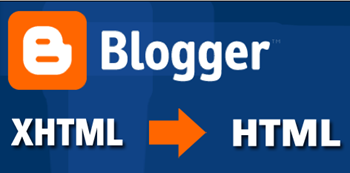This is our new series and would be fun sharing all the new development tips.
XHTML To HTML
Part1: XHTML To HTML: Blogger Template Conversion
Part2: In Progress...
Part3:
Purpose of This Tutorial
Purpose: XHTML is composed of XML and HTML 4. In this series we will learn to remove the XML portion of code and leave HTML 4 alone. Thus we will be able to create a static HTML Clone of a blogger template.Download and Study your Template
- Go To Blogger > Templates
- click Backup/restore
- Download your template
- Right click the downloaded xml file and choose "Open with > wordPad"
Every webpage has the following concrete HTML structure. Only the DOCTYPE element would differ in different platforms.
<!DOCTYPE HTML PUBLIC "-//W3C//DTD HTML 4.0 Transitional//EN">A webpage consist of 4 important sections
<html>
<head>
</head>
<body>
</body>
</html>
- The DOCTYPE defines the type and version of web language being used in the page. In Blogger & also wordpress the type is defined as XHTML and version as 1.0. The only difference is that wordpress uses transitional XHTML while Blogger uses the strict unforgivable version. Blogger doctype looks like this. You will find it at the top of your downloaded file.
<?xml version="1.0" encoding="UTF-8" ?>
The bolded part is the declaration for XML so that custom tags created using xml could be identified by the compiler. You wont find the bolded part in Wordpress blogs instead you will find the PHP opening tags.
<!DOCTYPE html PUBLIC "-//W3C//DTD XHTML 1.0 Strict//EN" "http://www.w3.org/TR/xhtml1/DTD/xhtml1-strict.dtd">
- The html tag enclosed both the head and body tags
- The head tag is where you add all your stylesheets (CSS) , scripts (JavaScript, jquery etc.) and meta tags (for SEO & platform compatibility purposes). Code inside head tags are visible to browsers only and not visible on webpage to visitors.
- The body tag contains your main content. This is the area where you add your Blog header, navigation, post section, sidebars and footer. Code inside body tag is visible on webpage. Any thing you add here will appear on your site and visitors will be able to see it.
All you need to do now is to identify the dynamic code sections and remove them from the template leaving behind static objects along with their related stylesheets and scripts. For that stay tuned for part2!
The Browser Wars
The day Netscape introduced their custom HTML tags which only their browser could interpret, started an ever growing war between browser companies like IE, Firefox, Opera, Safari and opera. Designers were finding it difficult to create a code that was compatible with all browsers, thus W3C stepped in and introduced XML. XML was used to write other web languages and was a common standard for all browsers. Since most pages were already coded in HTML using tags that no more are supported by modern browsers today, XML was use to create advanced HTML called XHTML. Since then XHTML has remained the standard to create fancy and colorful webpages. The same language is use to code Blogger and Wordpress platforms.To understand what is the basic difference between XML, HTML and XHTML, I would highly recommend that you read the great article written by hubpages folks.



 Freindly sites
Freindly sites Latest Blogger Tips
Latest Blogger Tips Follow me Facebook
Follow me Facebook Blog Statistics
Blog Statistics

 Twitter
Twitter